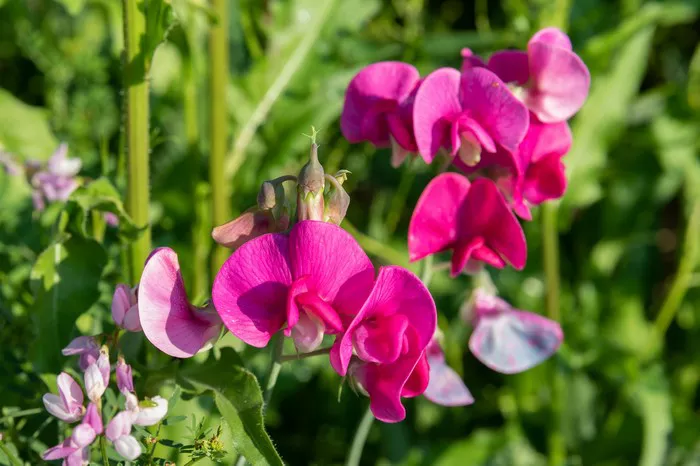Sweet peas, with their delicate tendrils and vibrant blossoms, have enraptured gardeners and flower enthusiasts for centuries. Their enchanting fragrance and exquisite appearance make them a beloved addition to gardens worldwide. One question that often arises among admirers of these charming blooms is: How long do sweet peas flower for?
In this comprehensive exploration, we delve into the intricate lifecycle of sweet peas, uncovering the factors that influence their flowering duration and offering insights for cultivating a flourishing display.
Understanding the Lifecycle of Sweet Peas
Before delving into the duration of sweet pea flowering, it’s essential to understand their lifecycle. Sweet peas (Lathyrus odoratus) are annual flowering plants belonging to the Fabaceae family. Originating from Sicily and southern Italy, these plants are renowned for their captivating fragrance and an array of colors, ranging from soft pastels to vibrant hues.
The lifecycle of sweet peas typically begins with the germination of seeds in early spring. Once planted in fertile, well-draining soil with ample sunlight, the seeds sprout and develop into seedlings. As the weather warms and daylight hours lengthen, the seedlings grow vigorously, producing lush foliage and eventually, a profusion of delicate flowers.
Factors Influencing Flowering Duration
Several factors influence the duration of sweet pea flowering, including environmental conditions, cultivar selection, and cultural practices. Understanding these variables can help gardeners optimize the bloom period and prolong the enjoyment of these captivating flowers.
1. Climate and Seasonality: Sweet peas thrive in cool, temperate climates and are often grown as spring or early summer annuals. In regions with mild winters, they may be planted in autumn for winter flowering. However, excessive heat can shorten the bloom period, causing plants to cease flowering prematurely.
2. Cultivar Selection: The choice of sweet pea cultivar significantly impacts the duration and intensity of flowering. Some cultivars are bred for their prolonged bloom period, while others may flower more prolifically but for a shorter duration. By selecting cultivars suited to their climate and preferences, gardeners can extend the flowering season and enjoy a continuous display of blooms.
3. Soil Quality and Nutrition: Rich, well-draining soil provides the foundation for healthy sweet pea growth and abundant flowering. Amending the soil with organic matter, such as compost or aged manure, enhances fertility and promotes vigorous plant development. Additionally, regular fertilization with a balanced fertilizer can supply essential nutrients, prolonging the flowering period.
4. Watering Regimen: Adequate moisture is crucial for sweet pea health and flowering success. Consistent watering, ensuring the soil remains evenly moist but not waterlogged, supports robust growth and sustained bloom production. During periods of drought or high temperatures, supplemental irrigation may be necessary to prevent stress-induced flower drop.
5. Light Exposure: Sweet peas thrive in full sun to partial shade, requiring a minimum of six hours of direct sunlight daily for optimal flowering. Insufficient light can result in leggy growth and reduced bloom production. By selecting a sunny location and providing adequate sunlight, gardeners can maximize the duration and intensity of sweet pea flowering.
Prolonging the Flowering Period
While the natural lifespan of sweet pea flowers is influenced by various factors, there are strategies gardeners can employ to prolong the bloom period and extend the enjoyment of these captivating blooms.
1. Deadheading: Regular deadheading, the removal of spent flowers, encourages continuous bloom production by redirecting energy towards the development of new buds. By snipping faded blooms at their base, gardeners can prevent seed formation and stimulate the plant to produce additional flowers.
2. Pruning and Training: Pruning sweet pea vines promotes bushier growth and increased flower production. Pinching out the growing tips when plants reach a height of 6 to 8 inches encourages lateral branching, resulting in more flowering stems. Additionally, providing support such as trellises or stakes enables vines to climb and prevents sprawling, optimizing space and sunlight exposure for abundant blooms.
3. Mulching: Applying a layer of organic mulch, such as straw or shredded bark, around sweet pea plants helps conserve soil moisture, suppresses weed growth, and regulates soil temperature. Mulching also provides a protective barrier for delicate roots, reducing stress and promoting healthy growth. As a result, sweet peas are better equipped to withstand adverse conditions and continue flowering prolifically.
4. Temperature Management: In regions with hot summers, providing afternoon shade or employing techniques such as shading cloth can mitigate heat stress and prolong the flowering period. Additionally, strategic planting near structures or taller plants can offer natural shelter and moderate temperatures, creating a more favorable microclimate for sweet pea cultivation.
5. Successional Planting: Sowing sweet pea seeds in successive batches at two to three-week intervals ensures a continuous supply of fresh blooms throughout the growing season. By staggering planting times, gardeners can extend the flowering period and enjoy a steady stream of flowers from spring to early summer.
Conclusion
Sweet peas captivate the senses with their enchanting fragrance and delicate beauty, making them a cherished addition to gardens and floral arrangements alike. While the lifespan of sweet pea flowers is influenced by various factors, including climate, cultivar selection, and cultural practices, gardeners can employ strategies to prolong the bloom period and extend the enjoyment of these beloved blooms.
By understanding the intricacies of sweet pea growth and implementing sound gardening techniques, enthusiasts can cultivate a profusion of flowers that dance in the breeze, delighting the eye and perfuming the air with their irresistible scent. Whether adorning trellises, borders, or bouquets, sweet peas continue to enchant and inspire, embodying the ephemeral beauty of nature’s fleeting wonders.


